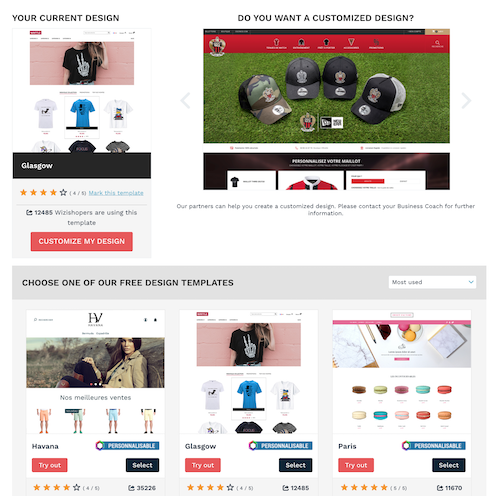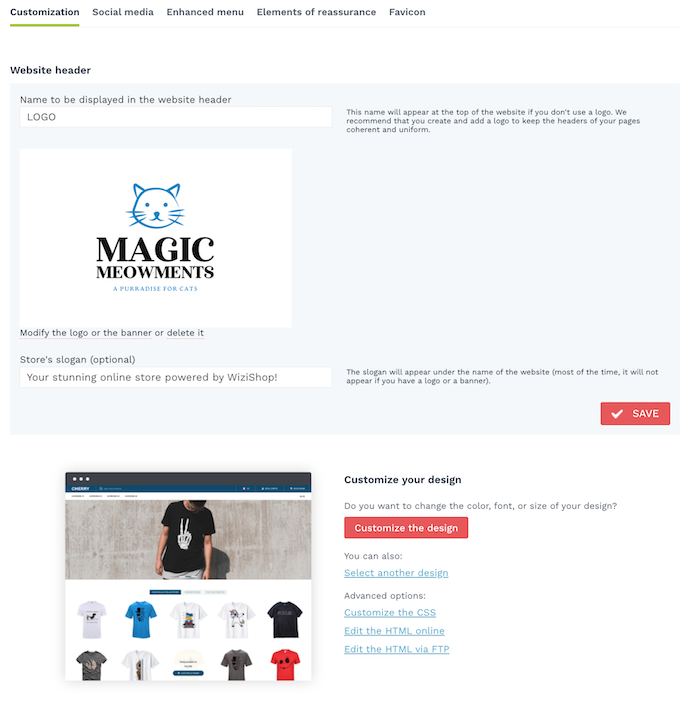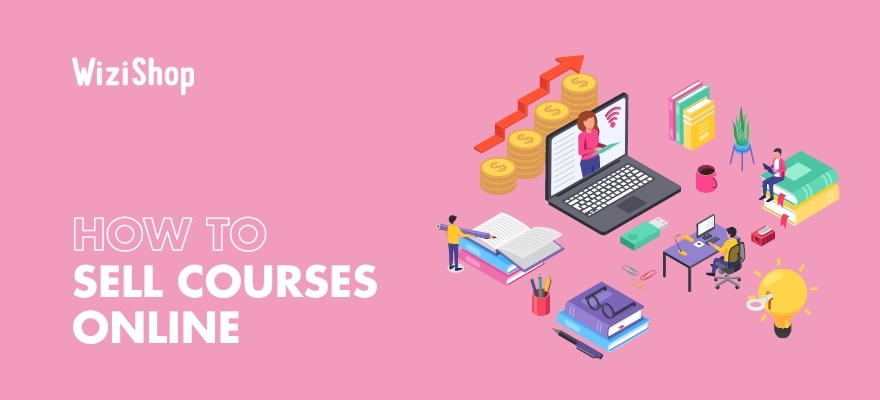Maybe you want to get your start in ecommerce sales by selling digital products like online courses, and there just so happens to be a particular topic that you have loads of expertise on that could benefit others.
Or perhaps you already have an online store that features tangible goods and believe that adding an online course to your catalog might aid in boosting sales for your existing physical products.
Selling online courses is an excellent way to share your knowledge and simultaneously earn a profit from your efforts. In this complete guide, we’ll explain why you might want to sell courses on the internet as well as provide you with a list of steps to take plus our best tips to help you successfully sell your own online course and build your ecommerce business.
Why create and sell courses online?
Before getting into the process of selling courses on the internet, let’s examine why you might want to do so. While your specific interest in offering online courses is going to depend on your unique goals for yourself and your business, here are several of the top reasons that make diving into the world of teaching on the web tempting!

The e-learning market is growing
When deciding on what products to sell on your ecommerce site, you’ll want to be sure that there’s going to be demand for your chosen goods in the foreseeable future. This is an important guideline to follow, no matter if your products are digital or physical.
However, it doesn’t look like the interest in online courses isn’t going anywhere anytime soon!
Sales of online courses grew dramatically during the height of the coronavirus pandemic and are expected to continue to increase in upcoming years. According to Forbes, the e-learning market is expected to reach $325 billion by 2025.
With a growing number of people around the world considering career changes for various reasons, the ability to take classes on the internet offers a convenient option that allows them to boost their knowledge and skills according to their schedules. This in turn means that creating your own course as an online business idea could turn out to be quite profitable for you!
You can establish yourself as a leader in your industry
A great thing about online courses is that they can be about any subject and can be created by anybody. If you have considerable expertise in and passion for a topic, why not share your knowledge with others and simultaneously earn a profit from it?
By creating online courses that assist your customers in solving a problem, learn something new, or gain valuable skills, you’ll be able to build your authority and establish yourself as a leader in your industry. As word spreads of your amazing online courses, you’ll start to see more site traffic and of course sell more of your product, but you can also use this to increase awareness of your brand and other products you offer.
There’s the potential of a high profit margin
One of the biggest advantages of selling intangible products like online courses over physical products is the potential for a higher profit margin.
With tangible goods, you need to invest money in the physical materials required to create the products, whether you create them yourself or pay somebody else to create them for you. You also need to maintain room to store tangible goods.
While this storage space may be minimal if your products are small or if you’ve just launched a new business, it’s also very possible that you’ll find yourself needing to rent a storage area, which can eat into any of the money you earn from potential sales.
However, with intangible goods, although you’ll need to spend time on making them, you won’t need to spend money on physical materials. What’s more, once you’ve created your online course, you can sell it over and over again—you don’t need to create a new one for every customer. In addition, it costs nothing to store digital products…whether you create one online course or 500 different online courses, there’s no difference!
You’ll be able to reach an even wider audience
No matter if you sell digital or physical goods, owning an online store already provides you with a number of advantages over owning a brick-and-mortar store. With an online sales site, you’ll generally have much lower overhead costs, lower barriers to entry, and the ability to cast a larger net with your target market.
Selling tangible items on the internet still involves shipping those goods to buyers, though. Depending on your budget and your location, you may be limited in where you can ship your products.
With digital products such as online courses, however, the sky’s the limit as far as getting your products to consumers goes! Because shoppers only need to download the item in order to access it, you can expand your audience and reach people across the globe.
Online courses are easy to manage, sell, and distribute
As you’ve likely gathered from some of the previously mentioned points above, managing, selling, and distributing a digital product like an online course is generally less complicated than doing so for a physical product.
Once you create your online course, it lasts forever and can be resold indefinitely. Although you may decide to update your course in the future, the initial product doesn’t need to be remade for every customer.
In addition, you won’t have to ever worry about your products being out of stock, regardless of the number of sales. You can sell as many downloads of your online course as you’d like, without any significant extra effort on your end.
After putting in the time and work to create your online course and then offering it to the public on the internet, there’s not much else involved in terms of day-to-day management. Nevertheless, you’ll still want to be sure to provide shoppers with customer service information in case they have any questions about your product or have issues accessing it after purchase.
Finally, as noted earlier, distributing digital goods after sales is super simple. After a customer buys your online course, they should be able to access it immediately. This is great for you as the business owner, as you don’t need to worry about shipping problems like lost or damaged packages, as well as for your customers, as they don’t need to wait to enjoy their order!
How do you start selling courses online?
Now that you have a better understanding of the benefits of selling courses online, there’s a good chance that the wheels are already turning in your head as to how you can get started with your own business involving e-learning.
Here are some important steps to follow as you begin your new adventure in ecommerce with the sale of online courses!
1. Select your course topic
As stated previously, online courses can be created on any topic. However, this doesn’t mean that you can create a course on anything and expect it to sell. It’s imperative that you choose a topic that’s going to be interesting to consumers and that’s going to want them to buy your product.
If the idea of selling a course online has crossed your mind, you probably already have a good idea of what topic you want it to be about. However, if you’re at a loss for inspiration, consider asking yourself the following questions in this list:
- What do you consider yourself to be an expert in?
- Is there a specific problem that your target audience deals with and that you know how to solve?
- If you already sell physical products on your ecommerce website, is there a topic related to those goods that your ideal customer could benefit from learning more about?
You might also think about asking the people in your inner circle as well as your followers on social media about what types of courses would interest them. If you have an already existing online store, you could check in with your subscribers in an email newsletter and request that they complete a survey on possible course subjects they’d like you to offer.
Keep in mind that once you have a general idea of what you want your course to be about, you’ll need to narrow it down to determine your particular niche. Plan to select a topic that’s specific enough to appeal to a smaller, yet more qualified, audience but broad enough to still give you some flexibility in the content you create.
Let’s use a course involving watercolor painting as an example, along with some topics you might consider.
- Too broad: “How to paint with watercolors”
- Too specific: “How to paint watercolor red roses”
- Perfect: “How to paint watercolor flowers”
With this third option, you’ll be creating content for a niche market and have much less competition than you would with the first option, but you’ll have much more freedom with content creation than you would with the second option. Besides roses, you could design courses on painting watercolor sunflowers, hydrangeas, geraniums, tulips, daisies, or any of your other favorite blooms!
Be sure to check out our article on the best-selling courses for further inspiration on what you might want to teach e-learning students!
2. Determine your learning goals and objectives for your course

After you have a better understanding of the type of training you want to offer, it’s advantageous to ask yourself what you hope to accomplish with your product. This means identifying the course’s learning goals and objectives.
Learning goals are the overall ambitions that you have for the people taking your course. They help you to explain what your course is about and how it can benefit students. In contrast, learning objectives, also referred to as learning outcomes, are the more specific skills and/or competencies that your students should be able to possess or perform after having completed your course.
Learning objectives also tend to be more measurable or assessable. For instance, with the example of the course on watercolor painting again, one of your learning goals may be to teach students how to easily paint watercolor flowers. Possible learning objectives, on the other hand, might be that by the end of the training, students should be able to explain the difference between various types of watercolor brushes or demonstrate knowledge of color mixing.
Setting learning goals and objectives will not only aid you in planning your course and the kinds of video modules you want to include but also give people an idea of what they can expect before purchasing your product. Furthermore, this information can additionally be used in your marketing efforts to promote your online course and attract additional website traffic and new customers!
3. Structure your course
Next on our list of steps is the act of planning what content you’d like to include in your online course. Although you’ll have already decided on your niche at this point, you’ll now need to take it a step further and dig deeper into the demographics of your target audience to structure your content.
What is your ideal buyer’s age? Favorite hobbies? Job? Lifestyle? Income level?
In addition, while you’ll hopefully be teaching a topic that you’re passionate about and that you enjoy discussing, it’s essential that you determine what it is that that your audience wants to actually learn when deciding on your course content. You’ll also want to be sure that your product offers something different from what similar courses may provide to make you stand out from the competition.
Throughout the process of structuring your online course, think about how many categories and subcategories you’d like to include and ensure that the order of the different video modules is logical for your students.
Using the example of teaching people how to paint watercolor flowers for instance, you wouldn’t want to start off your course with advanced watercolor techniques and then share techniques for beginners at the end. It’s very important here that you put yourself in the shoes of your customers and think about how you would have liked to have been taught when you were first learning about the topic.
Depending on your specific topic, though, it’s possible that module order is less relevant and that students can simply go to whichever modules they choose whenever they wish, without it being detrimental to grasping the material. In this case, you’ll still want to be sure to include an introduction and clear, well-planned categories to allow for easy navigation of your course.
4. Build your course content

Now that you know exactly what kind of content you want your online course to contain, you can get to the fun part: creating it!
This step is likely to take up a good chunk of your time, but remember that creating high-quality video content will be worth it. One of the disadvantages of selling digital products, including online courses, is that people in your target audience can often find a free version of whatever you sell. For this reason, it’s imperative that your online course is professional and that you provide students something that they can’t obtain elsewhere.
In addition, note that you’ll need to have a few materials and pieces of equipment on hand to create your course content.
To start, be sure that you have a good-quality camera for filming, professional lighting, editing software, and a green screen to make changing the background to anything you want a breeze during the editing process. You’ll also want to have a script ready, ideally used along with an app that makes it possible for you to convert your laptop into a teleprompter so that you can more easily read it while filming.
If you’re already pretty familiar with creating videos for use on the web, it should be fairly easy for you to film your video content yourself. However, if your video skills are limited and you have a decent budget, you can of course opt to hire somebody else to assist you with this too.
Finally, don’t worry if you don’t get your filming right in one take. No matter how well you know the script and the material in your course, getting in front of the camera can make for a completely different experience.
Start with a test recording just to ensure that you have the correct camera placement and that the sound level is where you want it to be. You’ll also want to check that the lighting is good and doesn’t cast any odd shadows on your or your background, keeping in mind that you may need to adjust this while filming.
5. Choose a platform for selling your course
It’s now time to decide where you want to sell your online course. Choosing a platform or software for hosting and selling your course can be overwhelming, as there are many different options on the market.
This step is important and deserves your time and attention, though! You’ll want to be sure that you choose a hosting platform that makes running your business as easy as possible while being a good fit for your needs and budget.
First, there are online course marketplaces, with some well-known platforms in this category being Udemy and Skillshare. Course marketplaces will take care of much of managing your course for you, allowing you to take a relatively hands-off approach.
However, this kind of hosting platform is often accompanied by a long list of rules to follow, limiting the amount of customization you can apply. Furthermore, course marketplaces’ transaction fees tend to be quite high, frequently charging up to 50% of the sales you earn.
You can alternatively opt to sell your course on an online course platform. These platforms generally provide much more flexibility and customization options and are more geared toward helping course creators build their businesses rather than simply sell their products. Examples in this category include platforms like Thinkific, Kajabi, Podia, Teachable, and many others.
However…did you know that it’s now possible to sell digital products like online courses in addition to physical goods on the WiziShop ecommerce platform? It’s true!
With our software's wide range of design template options, you’ll be able to build an online store that suits your brand perfectly. What’s more, our 400+ tools will allow you to easily manage your website and take your business even further.
Note that this also includes our revolutionary AI feature that makes it possible to generate different kinds of text content for your site in seconds, including blog articles, translations, product descriptions, and more, freeing up your time for other aspects of your business!
In addition, the WiziShop Business Coaches will be available to assist with any questions you may have about your online store—not just when you first launch your business but at any point in your ecommerce journey with us! You can chat with them about anything related to your ecommerce business, from learning how to increase site traffic to building your social media presence, optimizing your email marketing strategy, and more. You’ll also have access to free training modules on all kinds of subjects involved with selling on the web to ensure your best chance of success.
We offer numerous subscription plans with varying monthly rates. Simply select the subscription plan from the list that best meets your current requirements, knowing that you’re free to change your plan at any time as your business grows.
Finally, our SEO-powered ecommerce solution offers 50+ optimizations to ensure that your online store’s technical SEO is in great shape. To put it simply…Google is going to love your website.
To see for yourself what makes WiziShop the best platform to sell digital products, take advantage of our 7-day free trial today!
Try WiziShop free for 7 days
THE EASIEST NO-CODE ECOMMERCE SOLUTION✅ No credit card required
✅ Access to all features
✅ No commitment
6. Decide on the price of your course

Determining how you want to set the price of your online course can be tricky. If you’re feeling lost as to where to begin when it comes to product pricing, you’re not alone…it’s a common area of confusion for many course creators.
The right amount to charge people for your course will depend on the topic, your audience, and your level of expertise. While there’s a good chance that the price you set in the beginning will change as you develop your business and you have a better understanding of your target market, there are a few questions you can ask yourself to start off on the right foot:
- How much money did it cost you to create your course (considering investments in equipment, editing software, etc.) ?
- What are the costs of hosting your course on your chosen platform (be it Teachable, Thinkific, or another solution)?
- What kind of budget do you plan on allotting to your marketing efforts?
- How much are competing course creators charging for their courses?
- What price do you think your ideal buyer is willing to pay, based on their income level, to access your course?
When figuring out what kind of pricing strategy you’d like to use to monetize your courses, consider some of the most popular options you’ll find in e-learning.
- Free
While you obviously won’t earn any money directly from your course when you set the price as free, it can be a great way to build brand awareness and demonstrate your expertise. You can also use this strategy to generate leads for your other products. For example, if you create a more expensive course, you can use your free version to pique people’s interest and make them want to buy the upgraded option in the future.
- One-time payment
If you’re looking to earn revenue from your product, having learners make a single payment that grants them lifetime access to all of your course material is undoubtedly the simplest paid strategy. The shopper knows exactly what to expect from the beginning, and you’ll receive the full payment immediately.
- Subscription
Another option is to make your e-learning business a subscription or membership website where you’ll offer gated content that only subscribers can access. Besides providing members with access to your course, you might also create a membership community in which people can network with other subscribers to bring more value to your subscriptions.
With a subscription kind of pricing plan, your subscribers will make regular payments, allowing you to receive recurring revenue that you can depend on. While monthly or weekly payments are the most popular subscription options, you can of course set whatever schedule makes the most sense for you and your subscribers.
- Payment plan
A fourth pricing strategy to consider is to allow your customers to pay for your online course in installments, with the total amount of the installments resulting in a higher price than if the shopper were to pay for the course in one lump sum at the beginning.
For example, say that your product’s base price is $100. You can give people the option to either pay the $100 immediately or make three payments of $40, for example, meaning they’d ultimately end up paying a total price of $120 with the payment plan.
While you won’t receive all the revenue upfront, this strategy can make your course more accessible to a greater number of shoppers. In addition, it can result in more revenue in the long run.
7. Organize your content on your chosen platform
Once you have all your course content ready to go, you’ll need to upload your videos to the platform you’ve selected and organize them in a way that creates the best possible user experience for your customers.
While this is an especially crucial step if this is your first online course and you haven’t yet built up a reputation for your work, it’ll continue to be important as your business grows and you add more courses to the platform. Well-organized content will add to your professional image and show potential customers that their experience is important to you.
Depending on your chosen platform, items to organize may include your full catalog of courses, categories for the specific subjects your courses involve, and the individual videos in each course. The more thought you put into organizing your content, the easier it’ll be for people to find exactly what they’re looking for when browsing your website.
Returning to our trusty example of painting watercolor flowers once more, you might organize your course categories by skill or difficulty level, e.g., beginner, intermediate, or advanced; flower type, e.g., daffodils, roses, or violets; and video length, e.g., 0.5 hour, 1 hour, or 1.5 hours.
This way, students interested in a particular course, say a beginner’s course on painting violets, will have a much easier time being able to find the content and can begin learning as soon as possible!
As with anything in ecommerce, you may need to experiment with how you organize your content a bit until you find a strategy that works best for you and your customers. Nevertheless, if you’re creating your first course, a good starting point is simply to group your videos in a way that seems logical to you and will make the learning process as seamless as possible for students.
8. Customize your storefront or website
Ready to let your creativity run wild? It’s now time to let your brand’s personality show through via the customization of your storefront!
Based on the platform you’ve selected, your options for customizing your e-learning storefront will vary. However, regardless of the level of customization available to you, your aim should be to showcase your branding as much as possible to give your storefront its own, one-of-a-kind flair.
With WiziShop, for instance, you can start by choosing from our various professional design templates or working with one of our Partners to create a totally design for your ecommerce site.

You can then further customize your store by changing the color, font, or size of the elements in your chosen template. This is also where you can add items like your business logo, slogan, social media links, an enhanced menu, elements of reassurance, and your favicon to highlight your brand.

You might have already decided on all the important parts that make up your branding, but if not, keep in mind that consistency is key!
This means that everything like your brand’s logo colors, and messaging should be consistent across any site or page, e.g., your social media accounts, associated with your brand. Consistency will help your website visitors and followers to better remember and recognize your business. Furthermore, it can be reassuring to your current customers and encourage them to interact with your brand or purchase from you again in the future.
9. Test your product with a seed launch
You might understandably be a little nervous about sharing your online course with the public, especially if it’s your first one. After all, you’re putting yourself, your knowledge, and your product out there into the world. Even if you’re convinced that your course is educational and informative and that it can benefit a lot of people, you really won’t know how well it’ll go over with consumers until it’s live on your ecommerce website.
For this reason, you may want to consider a seed launch with a small group of consumers to test your product out beforehand. A seed launch will serve to demonstrate that there’s indeed a market for your course, discover a need for new tools or features you hadn’t thought of previously, and allow you to troubleshoot and fix any issues before the actual launch.
Fortunately, seed launches are very easy to implement once you have a near-final version of your product ready. They don’t require a ton of marketing effort on your end—just a bit of thoughtful preparation and reaching out to people who you think may be interested in your course.
Not sure who to ask to test your product in your community during your seed launch? Here are some possible groups to consider:
- Your inner circle, i.e., friends and family
- Your email newsletter subscribers
- Your followers on social media
- Your business contacts from your industry or networking events
In order to recruit as many testers as possible, you may want to offer people a free trial to test your course. If you’re worried about not earning revenue from your seed launch, note that the feedback you’ll receive during this test period may very well be invaluable to helping you to improve your product and attracting more customers in the long run.
10. Market your online course to attract sales

After all your hard work in preparing, creating, and finally launching your online course, you may be ready to relax and make your first online sale… Hang on, though!
Regardless of the quality of your product and how much effort you’ve put into it, it simply won’t sell if people don’t know that it exists. You’ll therefore need to spread the word about your online course once it’s live. Note that there are numerous avenues you can take in your marketing strategy to promote your product and boost awareness of your business.
- Social media
If you haven’t already created accounts on different social media networks, now is the time to do so! Social media marketing offers ecommerce entrepreneurs of all kinds a wealth of opportunities for building engagement with their audiences and connecting with current and potential customers alike, ultimately helping to drive site traffic and increase sales!
Through your research you conduct before creating your course and its content, you’ll find out which social media networks are most frequented by the people in your target market. You can then slowly work on building a presence on those platforms, offering content that not only promotes your brand but also answers your followers’ questions or that can help your audience with any problems they may face related to your product or niche.
- Emails
Don’t underestimate the power of thoughtfully crafted email newsletters for the success of your business!
Use email marketing to share important store updates, announce new products or features, tease upcoming sales, and provide other kinds of informative content to benefit your readers. Work on building your email list over time, via social media platforms, pop-up forms on your website, or gated content like a fun quiz for which users can only see the results after supplying their email address.
- Your website
Your website itself serves as a powerful marketing tool to promote your business. Regardless if you’re launching your first course or your hundredth, your website should be optimized to ensure an enjoyable user experience and include various elements designed to build trust and entice visitors to make a purchase, such as well-crafted product descriptions, high-quality photos, customer testimonials, your contact details (email address and/or phone number), clearly defined terms of service, etc.
You may also want to consider adding a blog to your website as another form of content marketing, posting articles to boost engagement and awareness of your brand. Although it’s best not to use your blog as an advertising platform, your blog posts can be related to your products and industry, serving to inform people in your target audience about topics that are likely to interest them.
11. Continue to work on improving your online course
While it’s true that digital products like online courses only need to be created once and can then be sold over and over again, it’s still quite probable that you’ll need to update your content at some point. No matter what topic your course entails, there are bound to be new techniques, technology, and strategies that you can integrate into your video modules to better help your students succeed.
Keep in mind that there’s no need to wait passively on the sidelines to improve your course if you find that your online store isn’t selling. Take a proactive approach by soliciting feedback from your customers at different stages.
For example, when they first purchase your product, ask what they hope to achieve after completing the training. You can then check in with them again after they’ve finished the course to see how far they think they’ve progressed. Don’t forget to also ask how they think your product could be improved.
Additional steps you can take to improve your course and attract more customers include working to best appeal to a variety of learning styles; incorporating interactive elements like quizzes, surveys, feedback forms, and gamification; and providing engaging content that encourages users to not only complete the current course they’re on but also look forward to purchasing another e-learning product from you down the road.
WiziShop: The best place to sell online courses and share your knowledge with the world!
There’s no doubt that the e-learning market will continue to expand as people’s desire for flexibility regarding education and skill improvement increases all over the globe. If you have extensive expertise in a particular topic and like the idea of sharing your knowledge with others, why not begin taking advantage of this booming market today?
Creating and selling online courses is a great method to launch yourself into the exciting world of ecommerce or help promote the physical products that you sell on your online store.
Either way, we at WiziShop would love to accompany you as you start your new adventure in e-learning and help your sales skyrocket. With our software, you can immediately get to work on building a customized website that best suits your vision, add your courses, avail of our plethora of tools to market your offerings, and get helpful advice from our dedicated Business Coaches to guide your strategy!
Try WiziShop free for 7 days
THE EASIEST NO-CODE ECOMMERCE SOLUTION✅ No credit card required
✅ Access to all features
✅ No commitment
Selling courses online FAQ
How profitable is selling online courses?
Selling online courses can be highly profitable for course creators due to low overhead costs and scalability. Once created, courses can be sold to an unlimited number of students worldwide with minimal additional expense. Profits depend on course quality, marketing effectiveness, and niche demand.
What are the best online courses to sell?
The best online courses to sell typically address high-demand skills or knowledge gaps. Popular topics include technology (like coding and data science), personal development (such as leadership and productivity), creative arts (like photography and painting), health and wellness (such as yoga and nutrition), and professional certifications. Courses that offer practical, actionable skills or lead to certification tend to attract more students and command a higher price, enhancing profitability.
Where do you sell courses online?
To sell online courses, popular platforms like Udemy, Thinkific, Coursera, and Teachable offer extensive reach and tools, handling everything from hosting to payment processing. Alternatively, selling classes on your own website provides complete control over branding, pricing, and customer data.
Which website is best for selling courses?
The best website for selling online courses depends on your specific needs.
For instance, Udemy is ideal for reaching a vast audience without needing marketing skills, as it handles promotion. Teachable, on the other hand, offers more customization and control over branding and pricing, making it suitable for creators looking to build a business. For those seeking an all-in-one solution with advanced marketing tools, Kajabi is excellent, though it comes at a higher cost.
Of course, if you wish to have the most control possible, you'll want to launch your own website to sell your offerings, building your online store with a top-notch solution like WiziShop!
How do you sell an online course without an audience?
Earning sales from an online course without an existing audience or community requires strategic marketing several steps to build visibility. Begin by optimizing the course for SEO to attract organic search traffic. You can then utilize pay-per-click advertising on platforms like Google and Facebook to target specific demographics.
In addition, you can build your community by collaborating with influencers or experts in your field to leverage these content creators' audiences. Don't hesitate to also supply free content like webinars or sample lessons to generate leads, and use email marketing to nurture these leads into paying customers.










